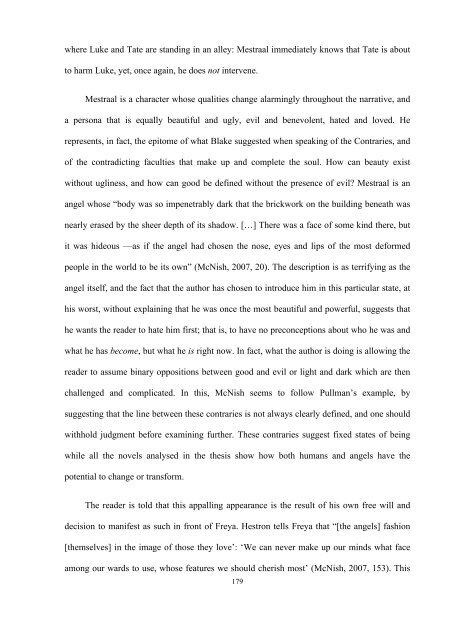The secular angel in contemporary children's literature: David ...
The secular angel in contemporary children's literature: David ...
The secular angel in contemporary children's literature: David ...
Create successful ePaper yourself
Turn your PDF publications into a flip-book with our unique Google optimized e-Paper software.
where Luke and Tate are stand<strong>in</strong>g <strong>in</strong> an alley: Mestraal immediately knows that Tate is about<br />
to harm Luke, yet, once aga<strong>in</strong>, he does not <strong>in</strong>tervene.<br />
Mestraal is a character whose qualities change alarm<strong>in</strong>gly throughout the narrative, and<br />
a persona that is equally beautiful and ugly, evil and benevolent, hated and loved. He<br />
represents, <strong>in</strong> fact, the epitome of what Blake suggested when speak<strong>in</strong>g of the Contraries, and<br />
of the contradict<strong>in</strong>g faculties that make up and complete the soul. How can beauty exist<br />
without ugl<strong>in</strong>ess, and how can good be def<strong>in</strong>ed without the presence of evil? Mestraal is an<br />
<strong>angel</strong> whose “body was so impenetrably dark that the brickwork on the build<strong>in</strong>g beneath was<br />
nearly erased by the sheer depth of its shadow. […] <strong>The</strong>re was a face of some k<strong>in</strong>d there, but<br />
it was hideous —as if the <strong>angel</strong> had chosen the nose, eyes and lips of the most deformed<br />
people <strong>in</strong> the world to be its own” (McNish, 2007, 20). <strong>The</strong> description is as terrify<strong>in</strong>g as the<br />
<strong>angel</strong> itself, and the fact that the author has chosen to <strong>in</strong>troduce him <strong>in</strong> this particular state, at<br />
his worst, without expla<strong>in</strong><strong>in</strong>g that he was once the most beautiful and powerful, suggests that<br />
he wants the reader to hate him first; that is, to have no preconceptions about who he was and<br />
what he has become, but what he is right now. In fact, what the author is do<strong>in</strong>g is allow<strong>in</strong>g the<br />
reader to assume b<strong>in</strong>ary oppositions between good and evil or light and dark which are then<br />
challenged and complicated. In this, McNish seems to follow Pullman’s example, by<br />
suggest<strong>in</strong>g that the l<strong>in</strong>e between these contraries is not always clearly def<strong>in</strong>ed, and one should<br />
withhold judgment before exam<strong>in</strong><strong>in</strong>g further. <strong>The</strong>se contraries suggest fixed states of be<strong>in</strong>g<br />
while all the novels analysed <strong>in</strong> the thesis show how both humans and <strong>angel</strong>s have the<br />
potential to change or transform.<br />
<strong>The</strong> reader is told that this appall<strong>in</strong>g appearance is the result of his own free will and<br />
decision to manifest as such <strong>in</strong> front of Freya. Hestron tells Freya that “[the <strong>angel</strong>s] fashion<br />
[themselves] <strong>in</strong> the image of those they love’: ‘We can never make up our m<strong>in</strong>ds what face<br />
among our wards to use, whose features we should cherish most’ (McNish, 2007, 153). This<br />
179
















